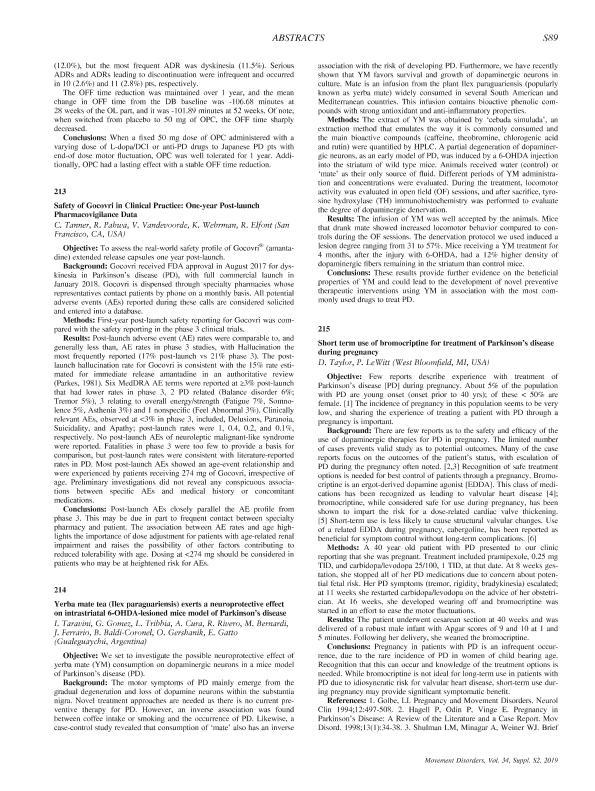Mostrar el registro sencillo del ítem
dc.contributor.author
Taravini, I. R. E.
dc.contributor.author
Gómez, G.
dc.contributor.author
Tribbia, Liliana Teresita

dc.contributor.author
Rivero, R. C.
dc.contributor.author
Bernardi, M. A.
dc.contributor.author
Ferrario, J. E.
dc.contributor.author
Baldi Coronel, B. M.
dc.contributor.author
Gershanik, O. S.
dc.contributor.author
Gatto, E. M.
dc.date.available
2021-06-29T17:14:34Z
dc.date.issued
2020
dc.identifier.citation
Yerba mate tea (Ilex paraguariensis) exerts a neuroprotective effect on intrastriatal 6-OHDA-lesioned mice model of Parkinson’s disease; 3rd Pan American Parkinson's Disease and Movement Disorders Congress; Miami; Estados Unidos; 2019; 89-89
dc.identifier.uri
http://hdl.handle.net/11336/135114
dc.description.abstract
Objective: We set to investigate the possible neuroprotective effect of yerba mate (YM) consumption on dopaminergic neurons in a mice model of Parkinson’s disease (PD). Background: The motor symptoms of PD mainly emerge from the gradual degeneration and loss of dopamine neurons within the substantia nigra. Novel treatment approaches are needed as there is no current preventive therapy for PD. However, an inverse association was found between coffee intake or smoking and the occurrence of PD. Likewise, a case-control study revealed that consumption of ‘mate’ also has an inverse association with the risk of developing PD. Furthermore, we have recently shown that YM favors survival and growth of dopaminergic neurons in culture. Mate is an infusion from the plant Ilex paraguariensis (popularly known as yerba mate) widely consumed in several South American and Mediterranean countries. This infusion contains bioactive phenolic compounds with strong antioxidant and anti-inflammatory properties. Methods: The extract of YM was obtained by ‘cebada simulada’, an extraction method that emulates the way it is commonly consumed and the main bioactive compounds (caffeine, theobromine, chlorogenic acid and rutin) were quantified by HPLC. A partial degeneration of dopaminergic neurons, as an early model of PD, was induced by a 6-OHDA injection into the striatum of wild type mice. Animals received water (control) or ‘mate’ as their only source of fluid. Different periods of YM administration and concentrations were evaluated. During the treatment, locomotor activity was evaluated in open field (OF) sessions, and after sacrifice, tyrosine hydroxylase (TH) immunohistochemistry was performed to evaluate the degree of dopaminergic denervation. Results: The infusion of YM was well accepted by the animals. Mice that drank mate showed increased locomotor behavior compared to controls during the OF sessions. The denervation protocol we used induced a lesion degree ranging from 31 to 57%. Mice receiving a YM treatment for 4 months, after the injury with 6-OHDA, had a 12% higher density of dopaminergic fibers remaining in the striatum than control mice. Conclusions: These results provide further evidence on the beneficial properties of YM and could lead to the development of novel preventive therapeutic interventions using YM in association with the most commonly used drugs to treat PD.
dc.format
application/pdf
dc.language.iso
eng
dc.publisher
John Wiley & Sons Inc

dc.rights
info:eu-repo/semantics/openAccess
dc.rights.uri
https://creativecommons.org/licenses/by-nc-sa/2.5/ar/
dc.subject
YERBA MATE TEA
dc.subject
PARKINSON¨S DISEASE
dc.subject
NEUROPROTECTION
dc.subject.classification
Neurociencias

dc.subject.classification
Medicina Básica

dc.subject.classification
CIENCIAS MÉDICAS Y DE LA SALUD

dc.title
Yerba mate tea (Ilex paraguariensis) exerts a neuroprotective effect on intrastriatal 6-OHDA-lesioned mice model of Parkinson’s disease
dc.type
info:eu-repo/semantics/publishedVersion
dc.type
info:eu-repo/semantics/conferenceObject
dc.type
info:ar-repo/semantics/documento de conferencia
dc.date.updated
2021-04-22T14:07:12Z
dc.identifier.eissn
1531-8257
dc.journal.volume
34
dc.journal.number
Suppl. S2
dc.journal.pagination
89-89
dc.journal.pais
Estados Unidos

dc.journal.ciudad
Nueva York
dc.description.fil
Fil: Taravini, I. R. E.. No especifíca;
dc.description.fil
Fil: Gómez, G.. No especifíca;
dc.description.fil
Fil: Tribbia, Liliana Teresita. Consejo Nacional de Investigaciones Científicas y Técnicas; Argentina
dc.description.fil
Fil: Rivero, R. C.. No especifíca;
dc.description.fil
Fil: Bernardi, M. A.. No especifíca;
dc.description.fil
Fil: Ferrario, J. E.. No especifíca;
dc.description.fil
Fil: Baldi Coronel, B. M.. No especifíca;
dc.description.fil
Fil: Gershanik, O. S.. No especifíca;
dc.description.fil
Fil: Gatto, E. M.. No especifíca;
dc.relation.alternativeid
info:eu-repo/semantics/altIdentifier/url/https://movementdisorders.onlinelibrary.wiley.com/toc/15318257/2019/34/S2
dc.relation.alternativeid
info:eu-repo/semantics/altIdentifier/url/https://movementdisorders.onlinelibrary.wiley.com/doi/10.1002/mds.27795
dc.relation.alternativeid
info:eu-repo/semantics/altIdentifier/doi/https://doi.org/10.1002/mds.27795
dc.conicet.rol
Autor

dc.conicet.rol
Autor

dc.conicet.rol
Autor

dc.conicet.rol
Autor

dc.conicet.rol
Autor

dc.conicet.rol
Autor

dc.conicet.rol
Autor

dc.conicet.rol
Autor

dc.conicet.rol
Autor

dc.coverage
Internacional
dc.type.subtype
Congreso
dc.description.nombreEvento
3rd Pan American Parkinson's Disease and Movement Disorders Congress
dc.date.evento
2019-02-14
dc.description.ciudadEvento
Miami
dc.description.paisEvento
Estados Unidos

dc.type.publicacion
Journal
dc.description.institucionOrganizadora
International Parkinson and Movement Disorder Society Pan American Section
dc.source.revista
Movement Disorders
dc.date.eventoHasta
2019-02-16
dc.type
Congreso
Archivos asociados
